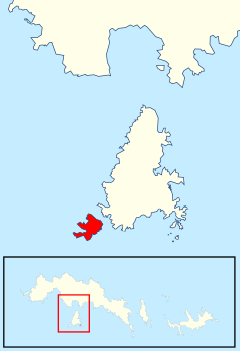Moe Island: Difference between revisions
Created page with "{{Infobox island |name=Moe Island |territory=BAT |picture= |picture caption= |latitude=-60.733 |longitude=-45.683 |map= |group=South Orkney Islands |population=Uninhabited |ar..." |
No edit summary |
||
| Line 6: | Line 6: | ||
|latitude=-60.733 | |latitude=-60.733 | ||
|longitude=-45.683 | |longitude=-45.683 | ||
|map= | |map=Moe Island by Signy Island - South Orkney Islands, BAT.svg | ||
|map caption=Location of Moe Island by Signy Island | |||
|group=South Orkney Islands | |group=South Orkney Islands | ||
|population=Uninhabited | |population=Uninhabited | ||
Latest revision as of 14:47, 21 May 2022
| Moe Island | |
| Location | |
| Location: | 60°43’59"S, 45°40’59"W |
| Data | |
| Population: | Uninhabited |
Moe Island is an island one nautical mile long in the South Orkney Islands, within the British Antarctic Territory. It is separated from the south-west end of Signy Island by the Fyr Channel.
The island was charted by Captain Petter Sørlle in 1912–13, and named after M. Thoralf Moe a Norwegian whaling captain from Sandefjord, Norway, who applied for a whaling licence for the South Orkney Islands in 1913-14 on behalf of A/S Corral (a subsidiary of Messrs Christensen and Co) and who worked in this area.[1] The northernmost point of the island is Spaull Point, named by United Kingdom Antarctic Place-Names Committee after Vaughan W. Spaull, British Antarctic Survey biologist on Signy Island, 1969.[2]
Antarctic Specially Protected Area
The island has been designated an Antarctic Specially Protected Area (ASPA 109) mainly for its biological values, especially the banks of Chorisodontium–Polytrichum moss turf and Andreaea–Usnea fellfield. The cryptogamic flora is diverse, though in places the moss turf is subject to damage by Antarctic fur seals. The mites Stereotydeus villosus and Gamasellus racovitzai, as well as the springtail Cryptopygus antarcticus, are common beneath stones.[3]
Important Bird Area
Moe Island has been identified as an Important Bird Area by BirdLife International because it supports breeding colonies of seabirds. Some 11,000 pairs of chinstrap penguins were recorded in 1978–79, though subsequently their numbers have declined with only about 100 pairs present in January 2006. Other birds recorded nesting at the site include Cape petrels, Antarctic prions and snow petrels.[4]
References
- ↑ Gazetteer and Map of The British Antarctic Territory: Moe Island
- ↑ Gazetteer and Map of The British Antarctic Territory: Spaull Point
- ↑ "Moe Island, South Orkney Islands". Management Plan for Antarctic Specially Protected Area No. 109: Measure 1, Annex A. Antarctic Treaty Secretariat. 2007. http://www.ats.aq/documents/recatt/att355_e.pdf. Retrieved 2013-09-22.
- ↑ Moe Island IBA: BirdLife International
